#Globicephala melas
Text

Southern long-finned pilot whale Globicephala melas edwardii
Observed by oscarkokako, CC BY-NC-ND
#Globicephala melas edwardii#southern long-finned pilot whale#Cetacea#Delphinidae#cetacean#dolphin#whale#Oceania#New Zealand#Pacific Ocean
23 notes
·
View notes
Note
Hi, This is sooo so very cool, I’m in the middle of my final exams right now and every so often I forget why I love biology, and chemistry and then I think dammit I should have just picked languages as my high level courses. But whenever I see your blog, I am reminded of why I want to study biochemistry. It’s just so insanely cool. Anyways, you don’t have to answer, but I just wanted to let you know. Many thanks!!!!
String identified:
, T c, ’ t a a gt a t gt g, a ct a t t at a t c agag a g c. t g, a at t t ct. t’ t a c. Aa, ’t a t a, t t at t t . a ta!!!!
Closest match: Globicephala melas genome assembly, chromosome: 19
Common name: Long-finned pilot whale (dolphin)

#tumblr genetics#genetics#the-name-was-lost#asks#YOOO FIRST DOLPHIN!!!#dolphins#also it makes me so happy to hear that this blog gets you excited about science again#i've almost quit several times. shit sucks#but it makes me so happy to see real scientists and students find joy in this silly little blog#you gotta push through. for the aminals#for the long-finned pilot whale (which is actually a dolphin)
654 notes
·
View notes
Text

Meet the long-finned pilot whale (Globicephala melas)! Reaching lengths of up to 25 feet (7.6 meters), it's the second largest member of the dolphin family; the orca is the largest. This nomadic cetacean is widely distributed, and can be seen throughout the oceans of the Southern Hemisphere. It wanders in search of food such as squid, fish, mollusks, and other sea critters. This species is highly social, with family units called pods consisting of up to 100 members. Pilot whales have even been observed participating in multi-pod gatherings with more than 1,000 individuals congregating at once!
Photo: titouan_roguet, CC BY-NC 4.0, iNaturalist
#science#nature#natural history#animals#mammal#whales#pilot whale#did you know#fact of the day#ocean life#dolphin#cetacean
384 notes
·
View notes
Text


(The Distortionist)
I unfortunately had to turn The Distortionist into a fish because it's MerMay (oh no)
(also for a little bit of story about this image, while deciding on what kind of sea creature to turn Christopher into, I originally thought of turning him in a shark (that's where the idea of the bottom left image came from), but nah I didn't fit for some reason. I had also considered turning him into a cephalopod (like a cuttlefish or an octopus) but nahh that felt too stereotypical even if cephalopods tend to be crafty and deceptive characters (although I did end up letting him keep the extra arms on his back). I end up settling on basing his lower half on a cetacean specifically a long-finned pilot whale (Globicephala melas) since cetaceans are also known for being very smart sea creatures and also the smooth, dark flesh of pilot whales just fit with the Distortionist for whatever reason.)
Oh also as a bonus I ended up drawing the Distortionist's head over a photo of an IKEA shark because I wanted to at least actually make the Distortionist into a FISH (the chris pierre fish design I settled on ended up just giving him the lower half of a pilot whale)
41 notes
·
View notes
Text

Long-Finned Pilot Whale (South Emisphere Form)
Globicephala melas edwardii)
Family: Delphinidae
Genus: Globicephala
Status and Conservation: Least Concern
This is the final subspecies in this small family, and they closely resemble each other. Distinguishing them requires expertise. This form, for instance, exhibits more prominent white stripes on its sides and top compared to the other subspecies, though the presence of this pattern is not exclusive to it. This form resides in the Southern Ocean near the Antarctic Pole, as its name suggests.
__________________________
Please consider joining the club where you can find more detailed information about every post here, spreads of the book that is in the making, and have access to the collectible E-Stickers.
Just click here
#long finned pilot whale#pilot whales#dolphin#whale#illustration#drawing#scientific illustration#illo#wild animals#wildlife#sea mammals#sea monsters#artist on tumblr#animals#mammals#animal
37 notes
·
View notes
Text

Grzimek's Animal Life Encyclopedia, vol. 11, Mammals II. 1972. Illustrated by Peter Barrett.
Beaked whales;
1.) Baird's beaked whale (Berardius bairdii)
2.) Strap-toothed whale (Mesoplodon layardii)
3.) True's beaked whale (Mesoplodon mirus)
4.) Sowerby's beaked whale (Mesoplodon bidens)
5.) Northern bottlenose whale (Hyperoodon ampullatus)
White whales and narwhals;
6.) Beluga whale (Delphinapterus leucas)
7.) Narwhal (Monodon monoceros)
Long snouted dolphins;
8.) Rough-toothed dolphin (Steno bredanensis)
9.) Atlantic humpback dolphin (Sousa teuszii)
True dolphins;
10.) Indo-Pacific bottlenose dolphin (Tursiops aduncus)
11.) Common dolphin (Delphinus delphis)
12.) Striped dolphin (Stenella coeruleoalba)
13.) Atlantic white-sided dolphin (Lagenorhynchus acutus)
14.) Common bottlenose dolphin (Tursiops truncatus)
15.) Risso's dolphin (Grampus griseus)
16.) Northern right whale dolphin (Lissodelphis borealis)
Pilot and killer whales;
17.) Long-finned pilot whale (Globicephala melas)
18.) Pygmy killer whale (Feresa attenuata)
19.) Irrawaddy dolphin (Orcaella brevirostris)
20.) Orca (Orcinus orca)
21.) False killer whale (Pseudorca crassidens)
Commerson's dolphins;
22.) Commerson's dolphin (Cephalorhynchus commersonii)
Porpoises;
23.) Harbour porpoise (Phocoena phocoena)
24.) Spectacled porpoise (Phocoena dioptrica)
25.) Dall's porpoise (Phocoenoides dalli)
26.) Indo-Pacific finless porpoise (Neophocaena phocaenoides)
#cetaceans#beaked whales#baird's beaked whales#strap-toothed whales#true's beaked whales#sowerby's beaked whales#northern bottlenose whales#belugas#narwhals#dolphins#rough-toothed dolphins#atlantic humpback dolphins#indo-pacific bottlenose dolphins#common dolphins#striped dolphins#atlantic white-sided dolphins#common bottlenose dolphins#risso's dolphins#northern right whale dolphins#pilot whales#long-finned pilot whales#pygmy killer whales#irrawaddy dolphins#orcas#false killer whales#commerson's dolphins#porpoises#harbour porpoises#spectacled porpoises#dall's porpoises
269 notes
·
View notes
Text
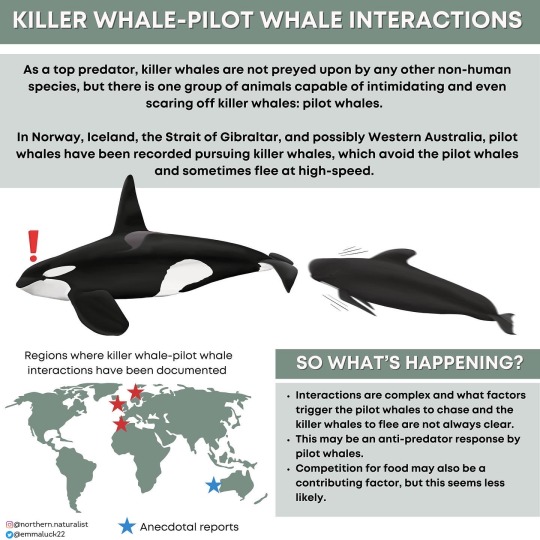
There’s not much that scares a killer whale. After all, it is a top predator capable of feeding on virtually any animal in the ocean. But there is one creature that can intimidate even killer whales—pilot whales.
In various parts of the world, long-finned pilot whales have been documented approaching and even chasing groups of killer whales. These interactions have occurred in Norway, Iceland, Spain, and there are anecdotal reports from Australia. Pilot whales may come charging into the area, harassing and pursuing a group of killer whales, which often respond by moving away and even fleeing at high speeds. I’ll never forget the day in Norway a few years ago when I was stuck at the house, unable to head out on the water for observations. On that particular day, a massive group of pilot whales appeared in the fjords, and the killer whales in the area all vanished for the rest of the day. The pilot whales had left by the following morning, and we managed to find a few killer whales that had returned, but it certainly gave me a lot to think about.
Curiously, pilot whales are attracted to killer whale calls, and upon hearing them, will respond by approaching the source of the sound, which may explain why they sometimes seemingly appear out of nowhere and start chasing the killer whales. Scientists suggest this behavior could be an anti-predator response to killer whales. Aggressively approaching the killer whales may be pilot whales’ way of saying “Hey, I can see you, get away from here!” There also may be some aspect of food competition, but this seems like a less likely reason as the diet of pilot whales and killer whales do not always overlap.
Another potentially important piece of this puzzle was revealed earlier this year when researchers in Iceland documented a tiny newborn pilot whale traveling with a pod a killer whales, with no other pilot whales in sight. Are killer whales calf-napping baby pilot whales?! There’s still much to be learned about these interactions.
References:
Curé C, Antunes R, Samarra F, Alves AC, Visser F, Kvadsheim PH, Miller PJO (2012) Pilot whales attracted to killer whale sounds: acoustically-mediated interspecific interactions in cetaceans. PLoS ONE 7:e52201.
Selbmann, A., Basran, C.J., Bertulli, C.G. et al. (2022) Occurrence of long-finned pilot whales (Globicephala melas) and killer whales (Orcinus orca) in Icelandic coastal waters and their interspecific interactions. acta ethol 25, 141–154
100 notes
·
View notes
Text
creature of the week: these fuckers

orcinus orca, commonly referred to as orcas or killer whales, are found fucking everywhere except for the arctic ocean, and specific and/or obvious spots such as the great lakes and the mediterranean sea.
they are a species of toothed whale in the family delphinidae, which means they're cousins with things like the bottlenose dolphin (tursiops truncatus) and the long-finned pilot whale (globicephala melas).

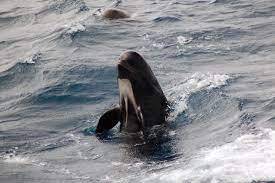
these sons of bitches had the audacity to be a god damn apex and eat stuff like fish, sharks (we'll come back to that in a minute), rays, seals, cephalopods, seabirds, sea turtles and other dolphin/whale species. they also hunt in packs because why fucking not. this got them the nickname "wolves of the sea".
with the fact that they eat sharks, this includes the god damn great white. they flip em over, and rip out their fucking liver.
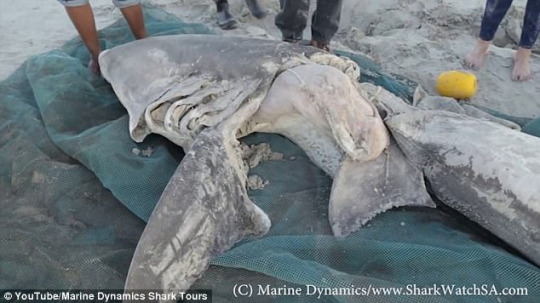
if you've noticed, i've been very harsh on these guys. i actually think they're really cool animals, and the fact that they have the black air force energy to pull this shit radiates big mood imo. they have the 2nd largest brain of any sea creature, only behind the sperm whale. i love these creatures, and would love to see them in their pods in the wild. they also really annoy me tho. i'm sorry but a shark-harassing honey badger dolphin does not deserve to be an apex. ignoring that they're an apex predator, they're at least in my top 15, maybe even top 10. that's why i gave them the honor of being my first creature of the week.
7 notes
·
View notes
Photo
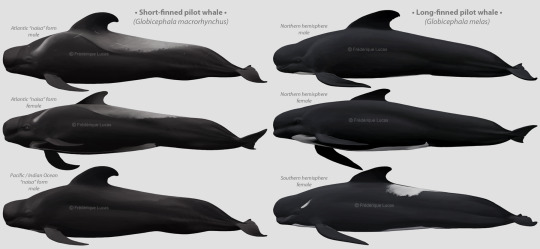
A plethora of pilot whales
The alliterations continue, as well as the uploading of illustrations from last year’s two big project. This time, pilot whales. A big and impressive relative of the killer whale, which come in two species: the Long-finned (Globicephala melas) and Short-finned (Globicephala macrorhynchus). Ironically pectoral fin length isn’t always a good identifier, but shape is a good call: in Short-fins the pectoral fins have a continuous sickle shape, whereas in Long-fins the pectoral fins have a single bend, and then taper out very straight.
Within the species there is diversity too. Long-finned pilot whales are the colder water species of the two, and thus their range is divided into a northern and southern population. Northern animals are quite plain black aside from the white anchor marking on their chest and belly. However Southern animals bear very striking white eye- and saddle patches, a bit reminiscent of killer whales.
Short-finned pilot whales live in warmer waters and Japanese fishermen had long known of two different types. Recent research showed these to be two distinct global subspecies: the “Shiho” form, living mostly in the Eastern Pacific but also off Northern Japan, and the “Naisa” form, living in the rest of the Pacific Ocean, as well as the Indian and Atlantic. They can be told apart by their saddle patch: the Naisa form has a long saddle patch reaching almost the end of the peduncle, whereas the Shiho form has a very short one. I only illustrated Naisa animals, but all pilot whales currently living at Seaworld are of the Shiho form and you can see the difference in saddle patch length.
Within the Naisa form there’s yet more differences. In the Pacific and Indian Ocean, Naisa’s have very muted colouration, as shown by the bottom illustration. It can be hard to even spot their saddle patches at all! However Atlantic animals are very brightly coloured with beautiful creamy markings sweeping up from behind their eye and into their prominent saddle patches.
#illustrations#scientific illustrations#Short-finned pilot whale#Globicephala mactorhyncus#Long-finned pilot whale#Globicephala melas#pilot whale#Globicephala#dolphin#blackfish#odontocete#subspecies#Naisa#Shiho#digital art
94 notes
·
View notes
Text

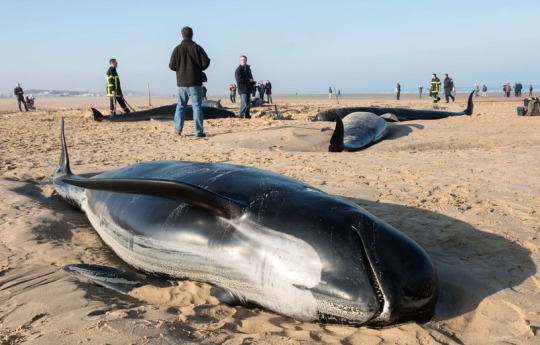


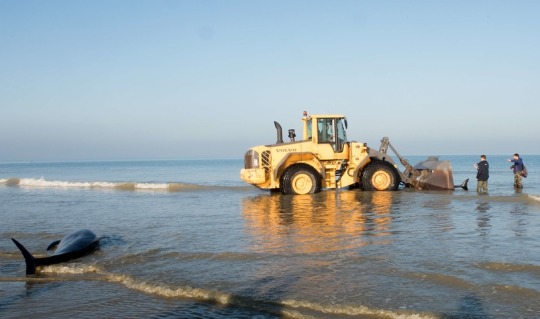

French firefighters and members of the local Animal Protection League (LPA) creating the conditions to rescue four long-finned pilot whales (Globicephala melas) beached on the shore of Calais.
#queue#found#Globicephala melas#long-finned pilot whale#long-finned pilot whales#oceanic dolphin#oceanic dolphins#Delphinidae#delphinid#delphinids#dolphin#dolphins#toothed whale#toothed whales#Odontoceti#odontocete#odontocetes#whale#whales#Cetacea#cetacean#cetaceans#Mammalia#mammal#mammals#Animalia#animal#animals#upload
30 notes
·
View notes
Photo

Northern long-finned pilot whale Globicephala melas melas
Observed by lospinguinos, CC BY-NC
#Globicephala melas melas#northern long-finned pilot whale#Cetacea#Delphinidae#cetacean#dolphin#Europe#Iceland#Atlantic Ocean
2 notes
·
View notes
Photo

34 notes
·
View notes
Text

🎼 00614 「Farewell (君に別離を)」。
2021年2月23日。今年の夏は 河原や海などで花火大会が催されるのかな、なんて思っていましたら、ニュージーランドのどこかにあります "フェアウェル岬 (Cape Farewell)" で ヒレナガゴンドウ (Globicephala Melas) 50頭弱が打ち上げられたさうです。理由は不明とのこと。そんな中、あたらしいお嬢さんと出会いました。
1 note
·
View note
Text

Long-finned Pilot Whale
Globicephala melas melas
Family: Delphinidae
Genus: Globicephala
Conservation Status: Least Concern
This whale is not a whale but a large dolphin. Despite the minimal differences between the Short-finned Pilot Whale and this species, they are indeed two distinct species. If that is not perplexing enough, this dolphin also possesses one subspecies—actually two, although one became extinct long ago along the coasts of Japan. In fact, scientists aren't sure that was a subspecies but almost sure. Let's say %93,2 sure.
You see, science is consistently regarded as an exact discipline.
Consider joining the club here.
No money? No problem. Follows, likes and shares will help too.
Hasta la vista.
#Long finned Pilot Whale#pilot whales#whales#dolphins#illustration#drawing#scientific illustration#illo#wild animals#wildlife#animals#artist on tumblr#mammals#whale#conservation#endangered species#extinction
34 notes
·
View notes
Text


Two cetacean skulls from the Museum of Science in Boston: a harbour porpoise (Phocoena phocoena) and a long-finned pilot whale (Globicephala melas).
Harbour porpoises are among the smallest marine mammals, with adults only reaching between 4.6-6.2 ft and 134-168 lbs. The species has a wide range, with different populations found in the coastal waters of the North Atlantic, North Pacific, and Black Sea. The species as a whole considered Least Concern by the IUCN with a population of at least 700,000 worldwide, however, certain specific populations are declining. The species is very well-known to whale watchers due to their abundance and preference for coastal waters.
Long-finned pilot whales are a large species of oceanic dolphin found in both the North Atlantic and the oceans of the Southern Hemisphere, with these two populations being classified as separate subspecies. Historically, a third population existed in the North Pacific but it became extinct around the 8th-12th centuries. Long-finned pilot whales are the most common cetacean species to be involved in mass strandings, with strandings of up to 1,000 animals being documented. Certain populations are considered to be at risk, however the species is considered Least Concern overall.
#vulture culture#natural history#osteology#museum of science boston#whale skeleton#whale skull#porpoise skull#dolphin skull
42 notes
·
View notes